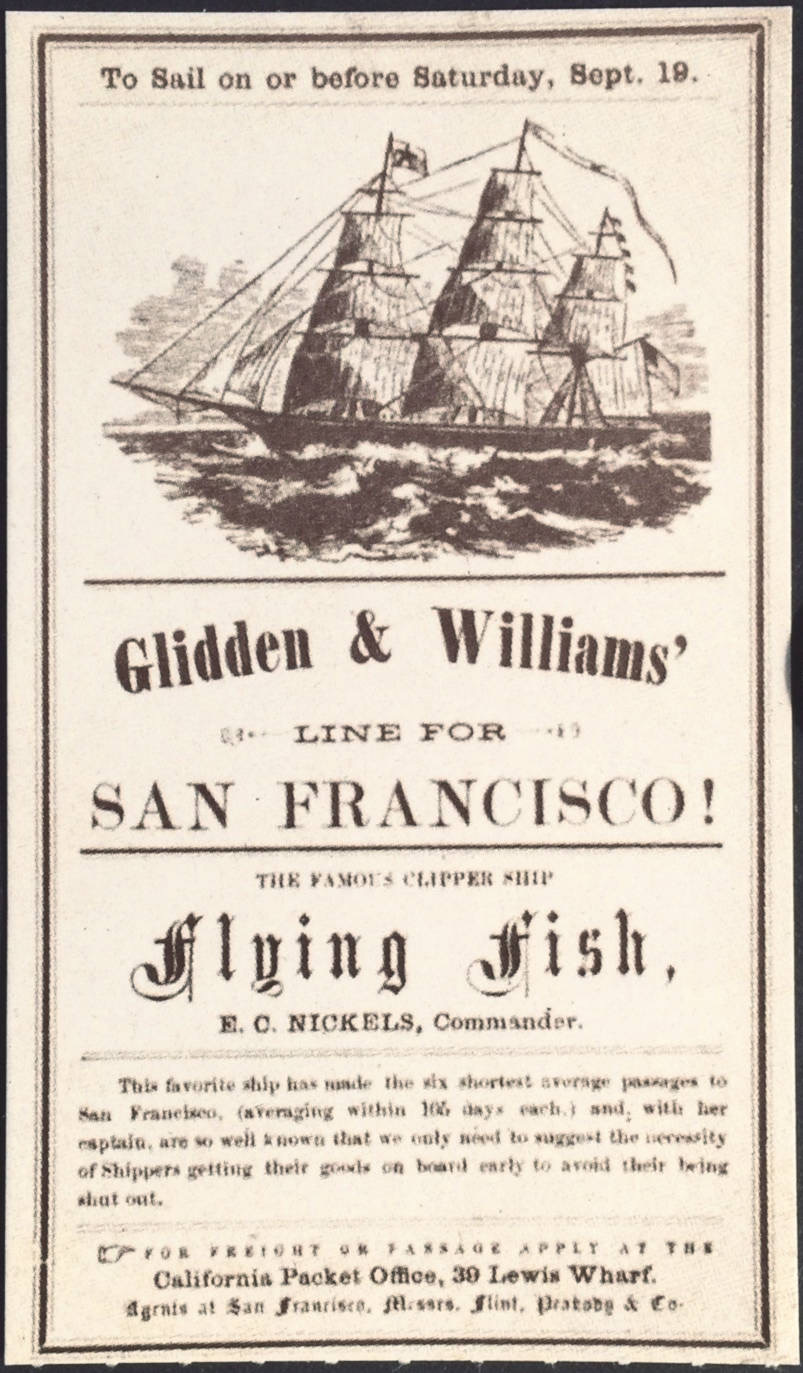
Poster in the public domain
The Flying Fish was built in 1851 by Donald McKay in East Boston. Her dimensions were 198’ x 38’ x 22’ with a tonnage (carrying capacity) of 1505 tons or over three million pounds of cargo.
1851 September
Launched at the shipyard of Donald McKay, East Boston, MA, for Messrs. Sampson & Tappan, Boston.
1851 November 11 - February 17
Sailed from Boston to San Francisco in 98 days. The Boston clipper Swordfish which left Boston on the same day arrived at San Francisco after 90 days and 16 hours.
1852 November 1 - January 31
Sailed from New York to San Francisco in 92 days and 4 hours. The Wild Pigeon left the same port on October 12, the John Gilpin on October 29, and the Trade Wind on November 14.
1853 May 6
Sailed from Manila to Boston in 107 days or 79 days from Anjer.
1853 September 20
Sailed from Boston to San Francisco in 113 days.
1854 April 2 - July 20
Sailed from Manila to New York in 109 days, 80 days from Anjer.
1854 September 23 - January 10
Sailed from Boston to San Francisco in 109 days.
1855 September 13 - December 27
Sailed from Boston to San Francisco in 105 days.
1856 October 4
Sailed from Boston to San Francisco in 106 days.
1857 September 28 - January 20
Sailed from Boston to San Francisco in 114 days.
1858 November 23
Left Foochow (China) for New York with a cargo of tea but missed stays and was wrecked at the Min entrance. The wreck was condemned and was surrendered to the underwriters who subsequently sold the wreck to a Manilla merchant. After having been rebuilt at Whampoa, Singapore, she was renamed the El Bueno Suceso.
To “miss stays” is for the ship to fail to make a tack, to move through the wind facing it from one direction to another. Here is a video of a square sailed ship making a tack:
I have not worked out the physics of this entirely. I don’t have the $800 for the tall ship sailing school that would cause it to make sense kinesthetically, although I do intend to participate in TWSA’s spring sailing class again. https://www.twsa.org/ This is not a tall ship sailing class but a normal sailing class with some kind of Catalina, usually, and wine afterward at The Social. But this is Tacoma, not Singapore.
There was no class last year due to Covid, but it looks like Tuesday nights we’ll be down at Foss Harbor borrowing someone’s boat. Someday we’ll be borrowing my budget boat and teaching the seasoned hands how to function with a two-stroke outboard and a full hull with no roller furler — although I can probably spring for a traveler — we’ll see. It might be easier just to sail the slick modern boats and forget about the art boat unless you really like art boats. Someone will want that, especially on Wednesday night -- and no one need be the wiser.
Charles Henry Dana gives a description of a similar catastrophe in his classic Two Years before the Mast: “She now lay over to it, the wind was freshening, and the captain was evidently ‘dragging on to her.’ His brother and Mr. R-, looking a little squally, said something to him, but he only answered that he knew the vessel and what she would carry. He was evidently showing off his vessel, and letting them know how he could carry sail. He stood up to wind-ward, holding on by the back-stays, and looking up at the sticks, to see how much they would bear; when a puff came which settled the matter. Then it was “haul down,” and “clew up,” royals, flying jib, and studding-sails, all at once. There was what the sailors called a “mess”—everything let go, nothing hauled in, and everything flying. The poor Spanish woman came to the companion-way, looking as pale as a ghost, and nearly frightened to death. The mate and some men forward were trying to haul in the lower studding-sail, which had blown over the sprit-sail yard-arm and round the guys; while the topmast-studding-sail boom, after buckling up and springing out again like a piece of whale-bone, broke off at the boom-iron. I sprang aloft to take in the main top-gallant studding-sail, but before I got into the top, the tack parted, and away went the sail, swinging forward of the top-gallant-sail, and tearing and slatting itself to pieces. The halyards were at this moment let go by the run; and such a piece of work I never had before, in taking in a sail. After great exertions I got it, or the remains of it, into the top, and was making it fast, when the captain, looking up, called out to me, “Lay aloft there, D--, and furl that main royal.” Leaving the studding-sail, I went up to the cross-trees; and here it looked rather squally. The foot of the top-gallant-mast was working between the cross and trusses trees, and the royal-mast lay over at a fearful angle with the mast below, while everything was working, and cracking, strained to the utmost.” Needless to say, they had to put in for repairs.
They would have had a crew of 20-30 salts from all over the globe and being very critical of the stupid captain. Mutiny was punishable by death, but sometimes you got to look the other way, man.
Information about The Flying Fish courtesy of http://www.bruzelius.info/Nautica/Ships/Clippers/Flying_Fish(1851).html
There is a wonderful model of The Flying Fish at the Maritime Museum in New York: https://gallery.collectorsystems.com/public/SouthStreetSeaportMuseum/5113/1991.069.0144
You can build a model of The Flying Fish for a mere $295 plus labor: https://hobbyworldinc.com/product/flying-fish-american-clipper-1851/
